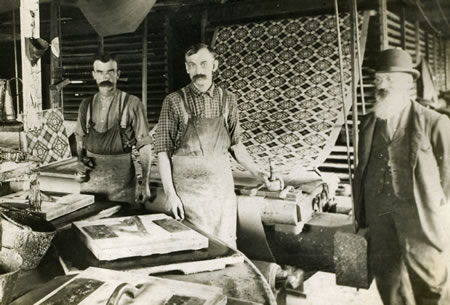Oilcloth
When I was a kid I saw references to oilcloth in crafts instructions, in old Girl Scout manuals, in books. If you look it up now or ask for some, they will show you and try to sell you vinyl-coated cloth, as for table cloths. But oil cloth wasn't plastic-coated. I'm not sure how it was made, but will collect references here.
When I was a kid in the 1960's, when I asked about oilcloth, all the older people I knew said sure, used to be common, not around. I think the old pieces were all cut up and used for other uses. And I'm guessing it was flammable and stinky and dangerous when it was old. (And maybe when it was new.)
Here's something I found written recently by someone older than I am:
Oilcloth
Submitted by Unka Jesse -locomotive builder. on Thu, 05/14/2009 - 12:27pm.
Back during WWII I spent my school vacations working on an ice wagon and many is the 50 pound chunk of ice I have placed in boxes like the one in the picture, but I never saw one that loaded from the back side. I remember one that I had to fill from the top. A lot of people out on rural routes did not even have an ice box but used a #2 galvanized wash tub to store their ice in. They had quilts in there as insulation and generally bought no more than 25 pounds at a time. 25 pounds sold for 10 cents as I remember it.
The table covering is another of those vanished items from the 1920s and earlier -- oilcloth. I can still smell it to this day. Not an unpleasant odor and quite serviceable. I have a Confederate cavalry sabre that has an oilcloth-covered handle wrapped with iron wire. My Rebel forefathers had to use oilcloth because leather was needed for horse harnesses, revolver holsters etc.
That came from a site called shorpy.com which is a blog (you can subscribe) collecting and restoring old photos. It has a link to Vintagraph, which sells prints of old posters and it's fun to just browse through those. Older people can tell stories to younger people. That's history in itself!
A description of older oil cloth from the catalog of a wholesaler of modern "oilcloth" (Oilcloth.com):
Original oilcloth was once made by treating canvas or linen with linseed oil and block printed with beautiful decorative designs. The original techniques have become rare and commercially obsolete with the introduction of non-cracking plastics and rotogravure printing process. Our “oilcloth” is a printed vinyl bonded and supported with a woven cotton mesh.
Image and notes from a museum in Hallowell, Maine (historicalhallowell.org)
Oil Cloth Factory (Hubbard Free Library Collection)

In 1826 the ice business began in earnest, employing thousands over the next 75 years; frozen blocks loaded onto Hallowell schooners traveled as far as Cuba and the West Indies. Other local products exported via the Kennebec (and, after the 1850's, by train) from Hallowell included sandpaper, textiles, rope, linseed oil, oilcloth, wire, books and shoes.
OH WAIT! This has lots of details on the history of oilcloth:
Oilclothblog: The Hstory of Oilcloth
18th century, England originally, used for floors and roof coverings at first.
Zebrite
 History for Unschoolers
History for Unschoolers
 Trivia
(i.e. "wont' be on the test")
Trivia
(i.e. "wont' be on the test")

